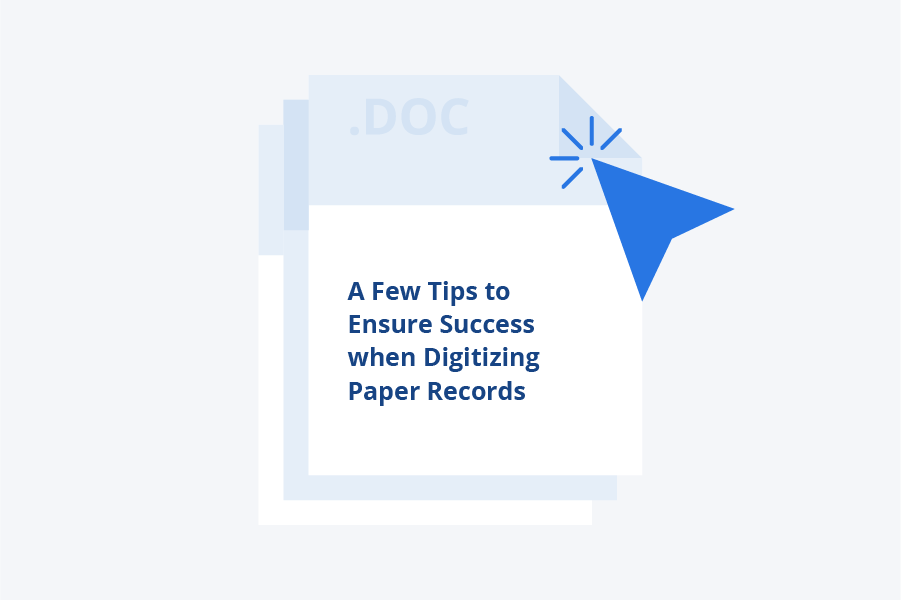A Few Tips to Ensure Success when Digitizing Paper Records

The past few years have driven many companies with predominately paper-based operations to take the necessary steps towards digitization. With remote work expected to increase into 2023, digitizing paper records will continue to be a business priority. Although organizations understand the need for digitization, the challenges associated with digitizing paper records can be overwhelming. Working with an expert outsource partner and developing a solid plan for implementation will help ensure the success of your digitization project.
 4 Tips for a Successful Digitization Project
4 Tips for a Successful Digitization Project
1. Ensure your project scope involves key stakeholdersIn order to develop a thorough project plan, it is important to identify the key people who will be using and accessing the documents to be digitized and include them as you begin to determine the project scope. Not only will involving key stakeholders in the project design help them feel more comfortable with the upcoming changes, it will also help you define important elements of the project such as: the most valuable format and file naming structure and relevant index criteria for searching and retrieving files.
2. Review your paper documents to help set budget expectationsTaking the time to understand the type of paper documents you have will help you more accurately set budget and timing expectations. As you review your paper documents and develop your budget outline, consider the following:
- Physical Characteristics - do you have documents that are irregular in size or that vary in format or quality? These variable factors will affect the project cost.
- Retention Requirements - are some documents at the end of their retention period? You may not have to digitally capture some older documents that are due for safe destruction. Consider purging the records to lower the overall volume required for digitization.
- Time Sensitivity - is there a specific deadline of when the paper documents need to be digitized? It's a good idea to prioritize those documents that should be captured first, possibly scheduling other documents for digitization at a later date as budgets allow. If these files are regularly used, make sure you discuss retrievals with your outsource provider to understand how quickly they can pull a record for you while in their custody and the associated costs, if any.
If you are able to digitally provide a record of which files are in which box, or some basic data relating to the records (i.e. employee names and ID numbers, or company codes and dates, etc) this information can be very helpful to your outsource scanning partner and assist in lowering project costs. Electronic manifests can be used to facilitate urgent retrievals of paper records during processing, if required. Having your electronic manifests on hand will also assist with file naming and indexing procedures providing an extra quality check and/or reducing the need for manual indexing.
4. Plan your electronic storagePrior to beginning your digitization project, ensure you have a plan in place for the storage of your new electronic files. Leverage an existing internal system to safely store the electronic records or work with your outsource provider to determine the best option. Partnering with Octacom will enable you to leverage Odiss to securely store your electronic files in a long-term archive that is accessible and searchable. As cloud-based document management software Odiss integrates with ERPs and ERMs (among other systems) and provides you with a safe and secure data archive with advanced workflow functionality.
The Octacom team partnered with Estée Lauder Cosmetics Ltd. (Canada) to help them with a digitization project involving their paper-based Human Resources employee records. Estée Lauder was using a manual process for the retrieving, handling, filing and distribution of their Human Resources employee records. Manual processes made it both time-consuming and labor-intensive for staff to retrieve and share documents. In addition, storing documents in their original paper format left them at risk for loss or damage.
The company wanted to convert their paper-based HR employee records to secure and easily retrievable electronic images and make them easily available online to their authorized users. Octacom offered Estée Lauder a proven Records Conversion Service to cost-effectively convert and archive their HR employee records.
Octacom is a SOC 2, Type II Audited enterprise software and services company focused on document and data automation solutions, including automated data capture. Founded in 1976, Octacom specializes in accounts payable automation and automated invoice processing, among other digital / automated business process outsourcing services.
If your organization is looking to learn more about our solutions and services, please contact us and we would be glad to help.
